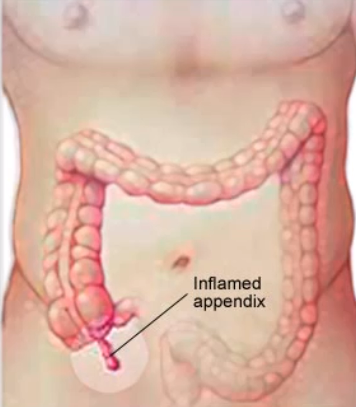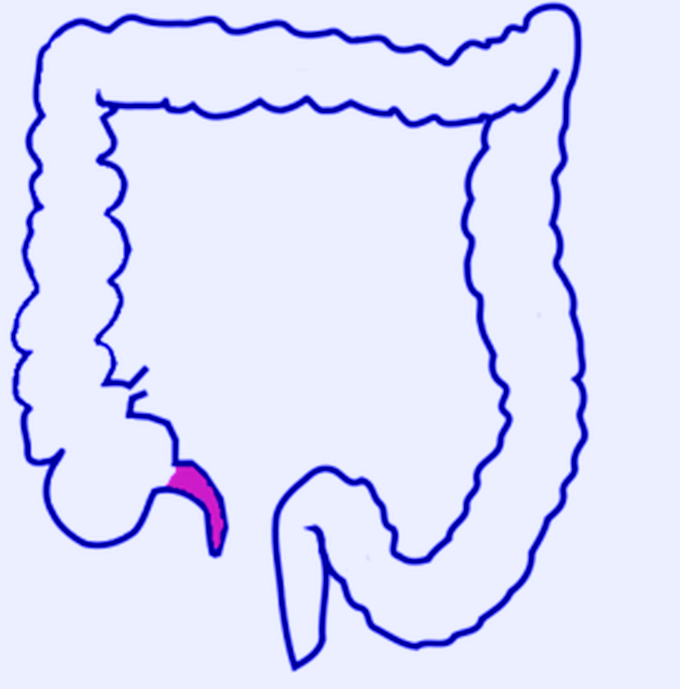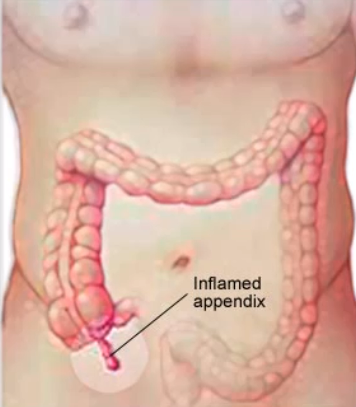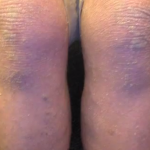What does appendix pain feel like ?
Appendix pain is one of the common complications experienced by numerous people around the world. This pain is often caused by a serious health issue called appendicitis. It occurs when the opening of appendix is obstructed. This causes the organ to be filled with mucus and swelling occurs. There are various factors that may cause blockage. These factors may include trauma, worm in the intestine, stool clogging the area or foreign body obstructing the opening of the organ. Irrespective of the factor causing the issue the affected individual will experience pain in mid-stomach which may later migrate to lower-right stomach in few hours. Appendicitis is a serious medical emergency; hence, you should understand its symptoms and seek medical attention immediately.
Appendix pain location

Appendix pain, as mentioned above, is experienced when the appendix is protruded due to appendicitis. Pain caused due to this condition is experienced initially in the upper abdomen around the navel region. In a few hours, the pain may then migrate to the lower-right stomach. If the pressure is applied to the stomach a sharp excruciating pain is experienced. This may in aggravate while walking, sneezing, coughing or performing an intense movement. However, in case of young women and children the location of appendix pain may vary. Apart from the pain, there are other signs or symptoms which may include nausea, vomiting, diarrhea, swollen abdomen, fever, constipation and reduced appetite.
Causes of Appendix of appendix pain
The exact cause of appendix pain caused due to appendicitis is unknown. However, there are various hypotheses in regards with cause of appendix pain. Some of these are as follows:
- Pain may be experienced due to an inflamed appendix. This in turn results due to obstruction caused by stools, foreign body or even tumor. Due to such obstruction, the bacteria starts to multiply themselves rapidly. This leads to inflammation of appendix and pus may get filled up.
- Inflammatory bowel diseases are also said to be a cause leading to obstruction of appendix opening. These diseases may include Crohn’s disease, ulcerative colitis, etc
- Another factor that may cause blockage of the appendix is parasite, for example, intestinal worms etc.
- Certain infections may also cause appendicitis. Gastrointestinal infection, caused either due to virus or bacteria, may reach to the appendix and cause inflammation
- Appendicitis may also occur due to any traumatic blow to the abdomen
There is no certain way to prevent appendicitis. However, it occurs less often in people who have fiber-rich diet such as grains, vegetables, cereals, fruits, etc.
Symptoms of appendix pain
It is beneficial to understand symptoms of appendicitis along with appendix pain. Appendix pain may be initially mild and may come in episodes, but later the pain may become intense and excruciating. This pain may become worse while exerting pressure on the abdomen such as while coughing, moving around, breathing deeply, sneezing, etc. This pain is often intense and may feel dissimilar than any other pain experienced before.
When the swelling of the appendix increases the pain may migrate to the lower-right abdomen. This pain is experienced at the location of the appendix which is between navel and right, close or at a position called the McBurney’s Point.
Along with pain, another common symptom of the condition experienced by most people is chills. Apart from this other signs of the condition include, mild fever, constipation, queasiness, diarrhea, decreased appetite, tremors, vomiting, difficulty passing gas, abdominal swelling and increased frequency of urination.
If the condition is left untreated the inflamed appendix may perforate or even burst, spreading the infection internally in the abdomen. This is a dangerous condition which is also called peritonitis which may prove to be fatal. Appendicitis symptoms can be similar to those of gastro-intestinal issues. Due to the similarity of symptoms surgeons come across normal appendix in approximately 30% of cases.
Appendix Diagram

Appendix Pain treatment
Usually for advanced cases of pain caused due to appendix inflammation, surgery is required. However, when surgery is not suggested or performed, doctors prescribe antibiotics to deal with infection to reduce dangers of peritonitis. Antibiotics are also administered to the patient before the surgery.
During the surgical procedure once the patient has administered the antibiotic, he/she is given anesthesia. There two ways of performing the surgery; one is through a four-inch incision and other through laparoscopic surgery wherein three holes are made in the abdomen and appendix is removed. Laparoscopic procedure is preferred because it takes lesser time to heal.
As mentioned above primary treatment against appendicitis is removal of the appendix through a surgical procedure named Appendectomy. Since there is no function that appendix performs in the body there is no risk involved in removing it. The success rate of Appendectomy is also 100% in seldom cases there are possibilities of anomalies. The recovery time for this surgical procedure is also very short as complete recovery takes merely 4 weeks to 6 weeks.
Though Appendectomy needs short time to recover, there are chances of complications. These complications may include:
- Uncontrollable Vomiting
- Blood in Vomit
- Dizziness or Drowsiness
- Fever
- Severe pain in abdomen
- Blood in urine
- Erythema or ache at the site of the incision
- Development of pus at the site of the incision
If any of the aforementioned complications is experienced one should immediately seek medical attention.
Appendix Pain Diagnosis
Since appendix pain is associated with the serious condition of Appendicitis, it is essential to get yourself diagnosed immediately. Initially, your doctor will do some physical evaluation in the clinic itself. He may ask you about the intensity of the pain, location of the pain and when it started. During your meeting with the doctor you should also inform him about any other symptom which will help him get further insight on the condition. Your doctor may also try to exert gentle pressure on the affected location to determine whether it causes pain. If it is appendicitis the pain will often become worse when the pressure is released suddenly. This indicates that the lining of the stomach cavity, or peritoneum, is inflamed.
To confirm the presence of appendix inflammation or appendicitis your GP may also suggest additional tests such as blood test. This will help in determining whether the count of WBC or White Blood Cell is higher. Increased degree of WBC often indicates infection. There are chances that your doctor may also suggest you the urine test. Urine test helps the doctor to determine whether UTI or Urinary Tract Infection or Kidney is the cause behind the experienced pain. To further confirm the condition your doctor may also suggest additional examinations such as ultrasound scan, X-ray, CT scan (Computerized Tomography scan). This will aid your GP to confirm appendicitis or find other cause of the condition.



My appendix Burst this sumemr….and it was extremely painful….so painful i almost had a stroke! be careful if you start throwing up, or feeling nausea go to the hospital immediately. When it bursts it gets quite complicated I was in the hospital for a month and had to have a tube inserted in my arms connected to my heart to get medication!!! couldnt exercise for 4 months!! be very careful!!!!!